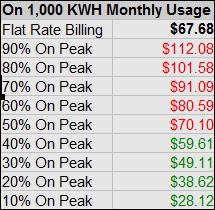Switch to Off Peak Electric Billing
 Most utilities offer two separate pricing systems, a traditional flat rate for electricity, and a time of day pricing. The reason for this is to encourage consumers to use electricity during off peak hours. Power plants are designed and built to handle peak demand, which is when the most electricity is being used. When demand is not at peak, the grid is over producing and the electricity generated is essentially wasted, the power plant receives no money for electricity that isn’t sold. The time of day pricing option was created to help with this, of course there is a catch. When using time of day pricing, the price for electricity used during peak times is increased above the normal flat rate, while the off peak electric pricing is substantially less.
Most utilities offer two separate pricing systems, a traditional flat rate for electricity, and a time of day pricing. The reason for this is to encourage consumers to use electricity during off peak hours. Power plants are designed and built to handle peak demand, which is when the most electricity is being used. When demand is not at peak, the grid is over producing and the electricity generated is essentially wasted, the power plant receives no money for electricity that isn’t sold. The time of day pricing option was created to help with this, of course there is a catch. When using time of day pricing, the price for electricity used during peak times is increased above the normal flat rate, while the off peak electric pricing is substantially less.
Indiana Michigan Power:
My utility provider is Indiana Michigan Power. Their flat rate for electricity is $0.0676 per KWH. When using time of day billing, On Peak electric use is charged at $0.12257 and Off Peak electric use is charged at only $0.01763. These prices are just for electrical generation and do not include the myriad of other fees the utility charges.
On peak and Off Peak Defined:
On peak hours are Monday through Friday 7 AM to 9 PM . Off Peak hours are M – F 9PM to 7AM and all day on the weekends.
Break Even Point:
With time of day billing the break even point is at 53% usage during off peak times. If you use more than 47% of your total electricity during on peak times then the cost for electricity will be greater than with flat rate billing. Below is a chart showing how this breaks down, a family that can shift 80% of its electricity use to off peak hours could save $30 a month, every month. It doesn’t seem like a lot, but that $360 a year invested at 8% over 30 years is $44,000! Even if you don’t plan on investing the money, any increase in delta is a win. The flip side of this of course is that without proper planning people could end up paying substantially more on their electric bill if too much On Peak power is consumed.
How To Make Time of Day Metering Work:
Time is on your side because Off Peak time contains more total hours than On Peak time. On Peak time is a total of 70 hours per week, while Off Peak time is a total of 98 hours. This means that base loads for your home like Refrigerators and freezers that are on 24/7 already have their energy split 58% onto off peak hours.
Time of Day pricing works best for families where no one is home during the day.
- Start the dishwasher at night before bed
- Do the laundry on weekends
- Turn off lights, cable box, computers, during the day before leaving in the morning.
Where this really makes a difference is for people with a plug in electric vehicle. Loading up on fuel during off peak hours at only 1.8 cents per KWH is a great deal! Time of Day metering certainly isn’t for everyone, but for those it makes sense for, there is some decent savings to be had.
Do you use Time of Day metering? How has it worked out for you?


Leave a Reply